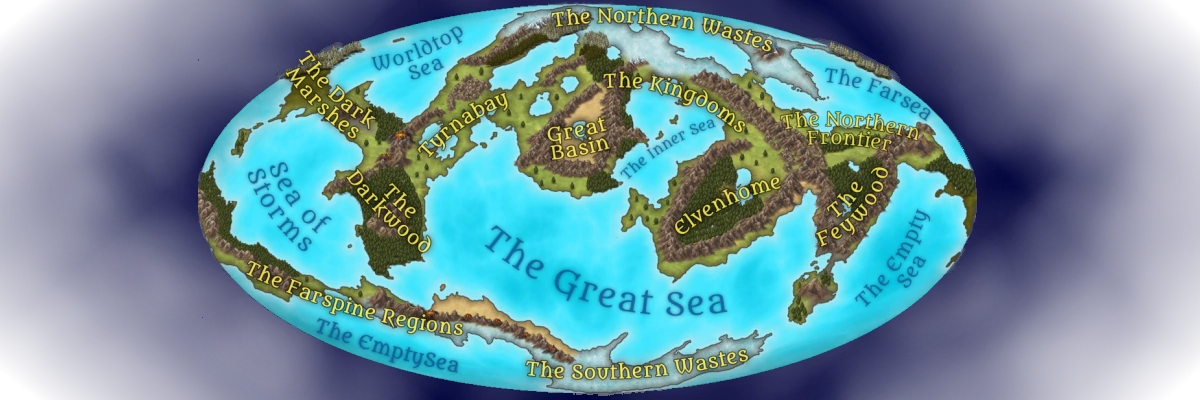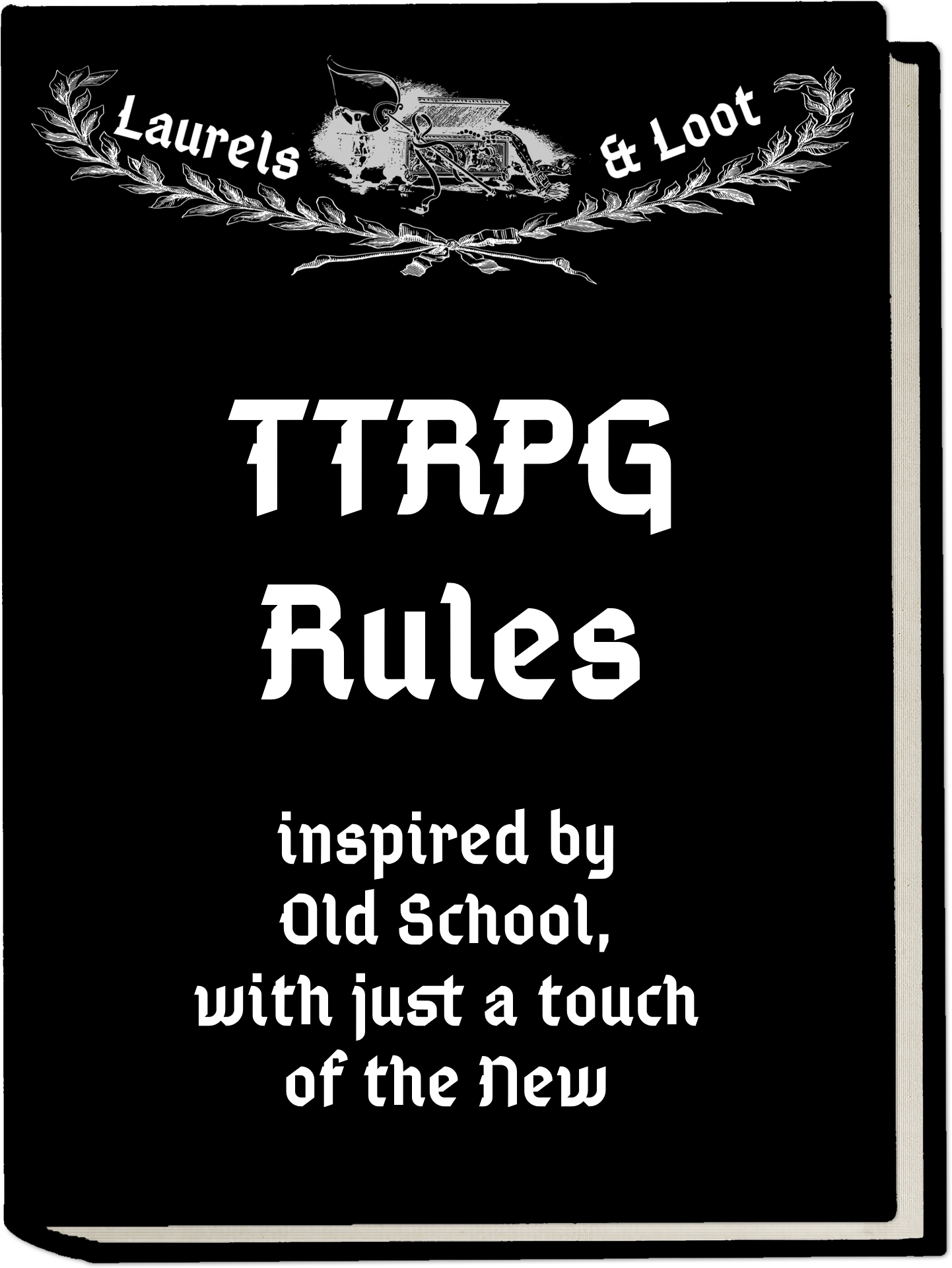
The World of Cartyrion
Welcome to the World of Cartyrion, a new campaign setting for your Role Playing Game! Untouched woodlands filled with magical creatures... frontier towns and villages... dark, haunted forests and ancient ruins with secrets to discover... palace intrigue and secret agendas of political and religious leaders alike... bustling cities... high seas pirates... and more!
Cartyrion has a place for any high fantasy game style and is compatible with any rule set, but here, you will also find the Laurels & Loot Fantasy RPG Rules, an old-school inspired system that's light on mechanics, fast to learn, and focused on opportunities to let player characters do spectacular things in search of fame and fortune.
Cartyrion has a place for any high fantasy game style and is compatible with any rule set, but here, you will also find the Laurels & Loot Fantasy RPG Rules, an old-school inspired system that's light on mechanics, fast to learn, and focused on opportunities to let player characters do spectacular things in search of fame and fortune.
What is it like to adventure in the Cartyrion's wondrous Feywood Forest?
See instructions at the top of the Adventure to learn how you can find out!
Players are being sought now!
See instructions at the top of the Adventure to learn how you can find out!
Players are being sought now!
Explore the World of Cartyrion with this interactive map:
Coming soon...
Cartyrion Character Guide
Almost a hundred player races, both purebred and hybrid;
numerous cultures and professions, and all the popular classes
-- all customized for the World of Cartyrion.
Adventures in the Feywood
A campaign-style series of adventures for characters of level one through five,
set in the Feywood region of the world.
The region features vast unexplored forests and fens, quaint villages,
and even a small city to adventure in.
Cartyrion Character Guide
Almost a hundred player races, both purebred and hybrid;
numerous cultures and professions, and all the popular classes
-- all customized for the World of Cartyrion.
Adventures in the Feywood
A campaign-style series of adventures for characters of level one through five,
set in the Feywood region of the world.
The region features vast unexplored forests and fens, quaint villages,
and even a small city to adventure in.
This is a work in progress.
The World of Cartyrion is vast, and there is much to do. At present, the gods, the people, the history, and the culture are painted only in the broadest of brush strokes, but the details are being filled in all the time.
The World of Cartyrion is vast, and there is much to do. At present, the gods, the people, the history, and the culture are painted only in the broadest of brush strokes, but the details are being filled in all the time.
There are two immediate projects underway.
The first is a series of adventures - a campaign, if you will - that are designed to introduce the players to the unique features of Cartyrion. These adventures are set in a portion of the world that some call the Frontier, but most simply call the Feywood. As these adventures are being designed, the details of the world are being filled in for this particular region.
The second is a work providing the detailed descriptions of all of the playable races and their sub-cultures, the backgrounds a player character might have had, and the adventuring classes that they will adopt as they journey through the world seeking their fortune.
The second is a work providing the detailed descriptions of all of the playable races and their sub-cultures, the backgrounds a player character might have had, and the adventuring classes that they will adopt as they journey through the world seeking their fortune.
I
A
n addition to the Player Character Creation Guide, there will be a complete Rules Compendium available under Open Gaming License. This rules compendium will be quite familiar to players of the two predominant TTRPG systems around today. It will attempt to streamline some complex rule subsets, fill in a few blanks, and add a number of additional features that are designed for the World of Cartyrion.
It will also feature extensive guidance for Game Masters and Players of all skill levels from neophyte to grognard.
It will also feature extensive guidance for Game Masters and Players of all skill levels from neophyte to grognard.
A
fter that, a complete Guide to the Deities and Cosmology of Cartyrion will be completed, as well as a complete World Atlas.
B
eyond these immediate goals, there are several other potential projects on the drawing board:
- A series centered in the Kingdoms - lands that consider themselves civilized, but are rife with intrigue, subterfuge, and conflict.
- A campaign series focusing on the seafaring races of Cartyrion. Adventure on the high seas with entirely new subcultures of existing player races.
- A series focusing on exploration of the "lost civilizations" of Cartyrion. The great god-war years ago caused great cities to fall, but civilizations rose and fell earlier as well. What secrets lie buried in their ruins?
If you are interested, be sure to Follow the World of Cartyrion.
If you'd like to know how you can support these efforts and get some "insider perks" at the same time,
check out Patreon.
If you'd like to know how you can support these efforts and get some "insider perks" at the same time,
check out Patreon.
Page banner created by Robert O'Brien on Inkarnate
Book Covers are based on an image by DarkmoonArt_de on Pixabay
Building a Character image made using HeroForge images
Adventures in the Feywood cover image by Robert O'Brien using Flowscape
Book Covers are based on an image by DarkmoonArt_de on Pixabay
Building a Character image made using HeroForge images
Adventures in the Feywood cover image by Robert O'Brien using Flowscape
Places to Visit in the Feywood
The World of Cartyrion has 109 Followers
Regional maps prepared using Inkarnate
Battle maps prepared using DungeonFog
(with many map assets courtesy of Caeora)
Artwork designated as being from Pixabay is governed by
Pixabay License
copyright© 2020, 2021, 2022, 2023, 2024, 2025 Robert O'Brien
Game Rules described herein are governed by
Open Game License version 1.0a
Descriptions of the World of Cartyrion, including, but not limited to its cosmology, deities, geography, political structures, religious sects, regional names, villages, towns, cities, and characters, are governed by Non-Commercial, Share-alike Creative Commonse License
Battle maps prepared using DungeonFog
(with many map assets courtesy of Caeora)
Artwork designated as being from Pixabay is governed by
Pixabay License
copyright© 2020, 2021, 2022, 2023, 2024, 2025 Robert O'Brien
Game Rules described herein are governed by
Open Game License version 1.0a
Descriptions of the World of Cartyrion, including, but not limited to its cosmology, deities, geography, political structures, religious sects, regional names, villages, towns, cities, and characters, are governed by Non-Commercial, Share-alike Creative Commonse License



